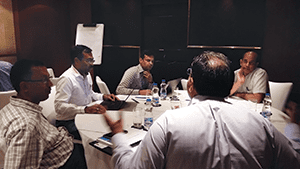
Consulting firm Mindtree’s revamped leadership model puts down its roots in leadership agility.
by Arva Shikari
August 17, 2017
Building a leadership pipeline is important, and a clear leadership model can link strategic areas of the business. For a fast-growing company like Mindtree with clients across the globe, development of that model and the leaders to go along with it was central to growth from inception.
Mindtree, an IT consulting firm founded in 1999 in Bangalore, India, by a group of 10 IT professionals, now employs more than 16,000 workers who provide e-commerce, cloud computing and digital transformation services from 43 offices in 17 countries, including a U.S. headquarters in Warren, New Jersey. The company booked revenue of $715 million in 2016.
Mindtree had done some coaching to build its leaders in the early days including a development experience led by the company’s former chairman, said Vidya Santhanam, Mindtree program director, people function.
But moving forward, the company chose to invest more heavily into leadership building after studying the state of the industry and talent. One challenge — thriving in an ambiguous environment — stood out in particular and formed the core of Mindtree’s leadership approach.
“We came up with the Mindtree Leadership Model in September 2011 to build recognizable leadership talent and create clear differentiators from competition,” said Santhanam.
Building a Leadership Model
Co-created with Korn Ferry International, the model is based on two foundational inputs: what the company expects from its leaders and benchmarks from best-in-class leaders. From there, the model measures three dimensions: learning agility, leadership competence and self awareness.
Learning agility — the ability of a leader to succeed in new situations — is the core of the model and is designed to measure a leader’s adaptability. An agile leader combines a number of traits — curiosity, comfort with ambiguity, interpersonal skills and resourcefulness.
Leadership competence is organized into four career tracks: Coach, Ninja, Thought Leader and Rainmaker. Each track is aligned to the decision-making styles of high performing leaders in the technology industry.
A Coach shares personal purpose, inspires people, creates a shared vision and develops talented people. A Ninja consistently delivers quality output and business value through operational excellence. Thought Leaders are creative thinkers and experts in an area relevant to Mindtree’s business, and Rainmakers have the capability and initiative to find customers, create new opportunities and develop segments that directly impact business.
Self awareness, the third dimension of the leadership model, means leaders deploy strengths in situations and effectively navigate challenges in areas that are weaknesses. Mindtree leaders are also required to seek feedback through leadership assessments like 360s and an individual feedback report. “Both these instruments are tightly integrated with our talent review succession planning which at any point of time leaders may reflect upon,” said Santhanam.
Each leadership role in Mindtree is linked to a primary and secondary career track, highlighting key skills a leader displays in a current role as well as skills they aspire to hone as they move to a destination role. During developmental career conversations or role transitions, the outcome of the leadership assessment focuses on role requirements and a leader’s primary and secondary competence area.
For example, a sales leader might display Rainmaker as primary competence and Ninja as secondary competence, meaning the leader needs to spot opportunities and convert them into business in addition to driving excellence when it comes to deliverables. A CEO’s primary competence would be a Coach and secondary competence a Thought Leader.
Bringing It to Life
The leadership model is aligned to Mindtree’s overall approach to talent management, including hiring, onboarding, assessment, performance and retention. Leaders are hired based on expertise for the role, key competencies and leadership behaviors and on-boarded with a structured, individualized plan. During the first week, the new leader defines their role and sets goals, works with peers, supervisors and eventually with others in the organization, customers and partners.
New leaders also begin to craft their network within the organization, meeting other Mindtree leaders to exchange ideas and experiences. Santhanam called the process “homing and cultural immersion.”
“We give them a holistic perspective to make the integration a strong one,” she said.
Throughout their leadership journey at Mindtree, leaders undergo an ongoing assessment and feedback process, including EDGE and Decision Dynamics assessments and debrief sessions. They also develop an individualized development plan for the annual talent review and integrate the output and development feedback from that talent review into leadership development, succession planning and role transitions.
Depending upon their goals, Mindtree leaders undergo one of two six- to eight-month learning programs, the enterprise management leadership journey or the enterprise technology leadership journey.
“Every leader can select an individual experience like coaching, mentoring or shadowing with our top management team in an investor or analyst meet,” Santhanam said. “Or they can mentor a start-up. They are also given a study assignment by the top management like a business situation and how would you take it four notches higher.”
Leaders also take part in group action projects set by the CEO or top management such as cognitive computing or prototype solutions for customers, she added. People are nominated for these projects after completing 18 months as a new leader.
Learning can take the form of coaching, field immersion, learning labs combining business issues and technology, action learning projects, experiential learning, external networking groups and what Santhanam called “learning from unusual sources.”

“Unusual sources include learning about managing complexity and publicity from the leading refineries in India or understanding performance management leaders by studying doctors or learning supply chain from a coffee estate,” she said.
Whatever route leaders take, the goal is to use the leadership model to help that leader become successful in their current or future role. “The outcome is individualized,” said Santhanam.
Making Change One Leader at a Time
The results from programs tied to the leadership model resulted in higher performance and retention. In one group of leaders who went through the enterprise management leadership journey in 2016, participants received a score of 85 percent in performance in their current role and the potential for transition into future leadership roles. Retention of those leaders remained high, too; 80 percent remain with the company.

Anecdotal feedback from leaders who completed learning programs tied to the model has been positive as well. Anoop George, associate vice president of sales at Mindtree and a 13-year veteran at the company, credited two training programs with changing him as both a salesperson and a leader.
George said the leadership development programs focused him on the people side of business and changed the way he thought about managing. “Previously, I focused a lot on short-term goals like revenue, profitability or closing a deal,” he said. “Over a period of time, I realized that the focus is on getting the right person and system to deliver.”
The coaching component also gave him a new view of what leadership looks like by exposing him to leaders across the company. “I could bounce new ideas or hear them come in and how you could succeed,” he said.
That experience has helped him move faster by visualizing how projects might work and motivate his team to perform better. “The biggest difference in my leadership behavior is the level of accountability,” he said. “I may have to step out of what I do and see the impact of it, how it affects everyone, what is the investment and how careful I need to be in how I do things.”
Leaders are the key connectors of business, bringing employees and customers together. The experience of Mindtree illustrates the role development plays in nurturing leadership capability through multipronged approaches to building the depth and breadth of experiences that will steer the company to its future.
Avra Shikari is a writer based in Mumbai, India. She can be reached at editor@CLOmedia.com.



